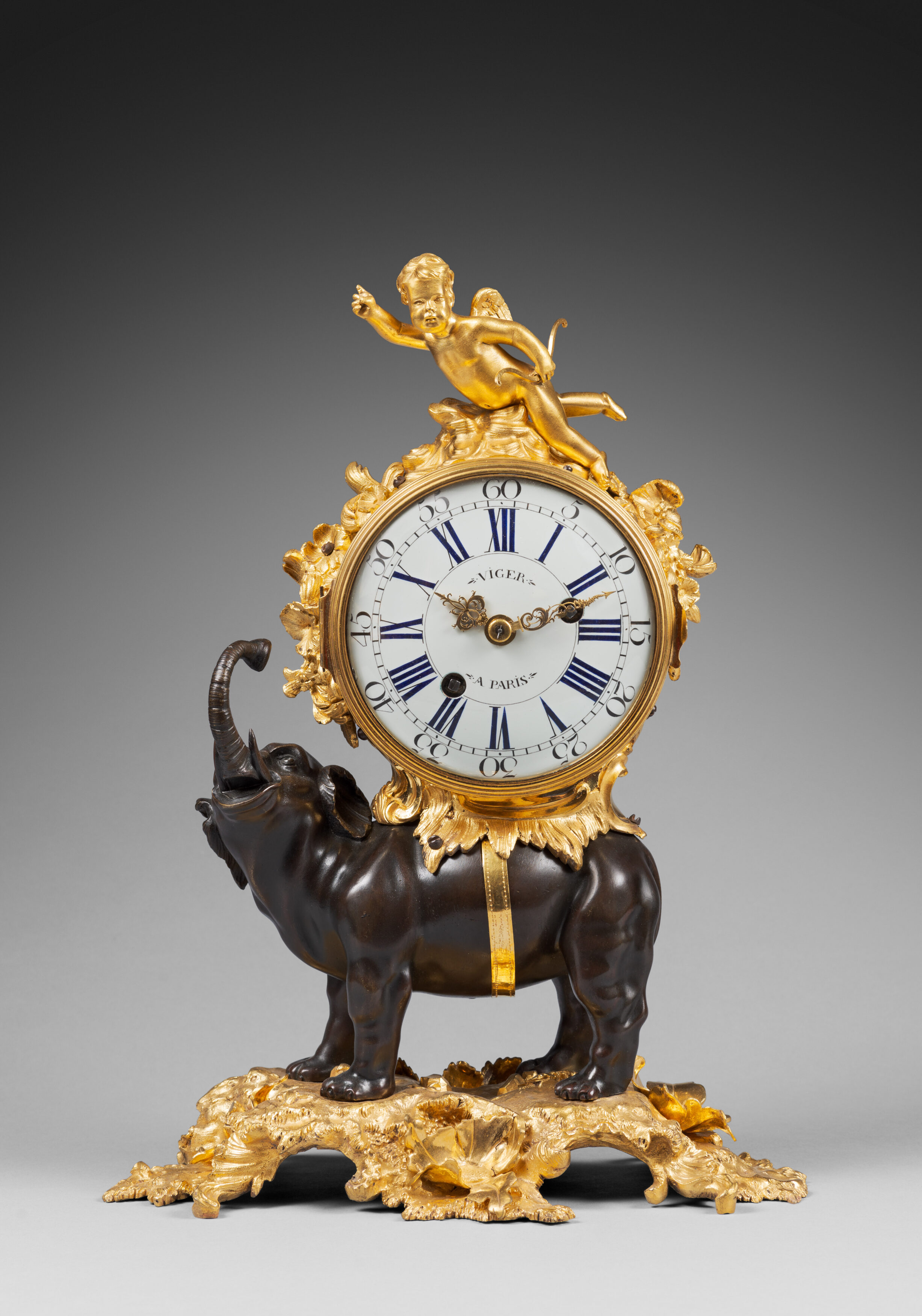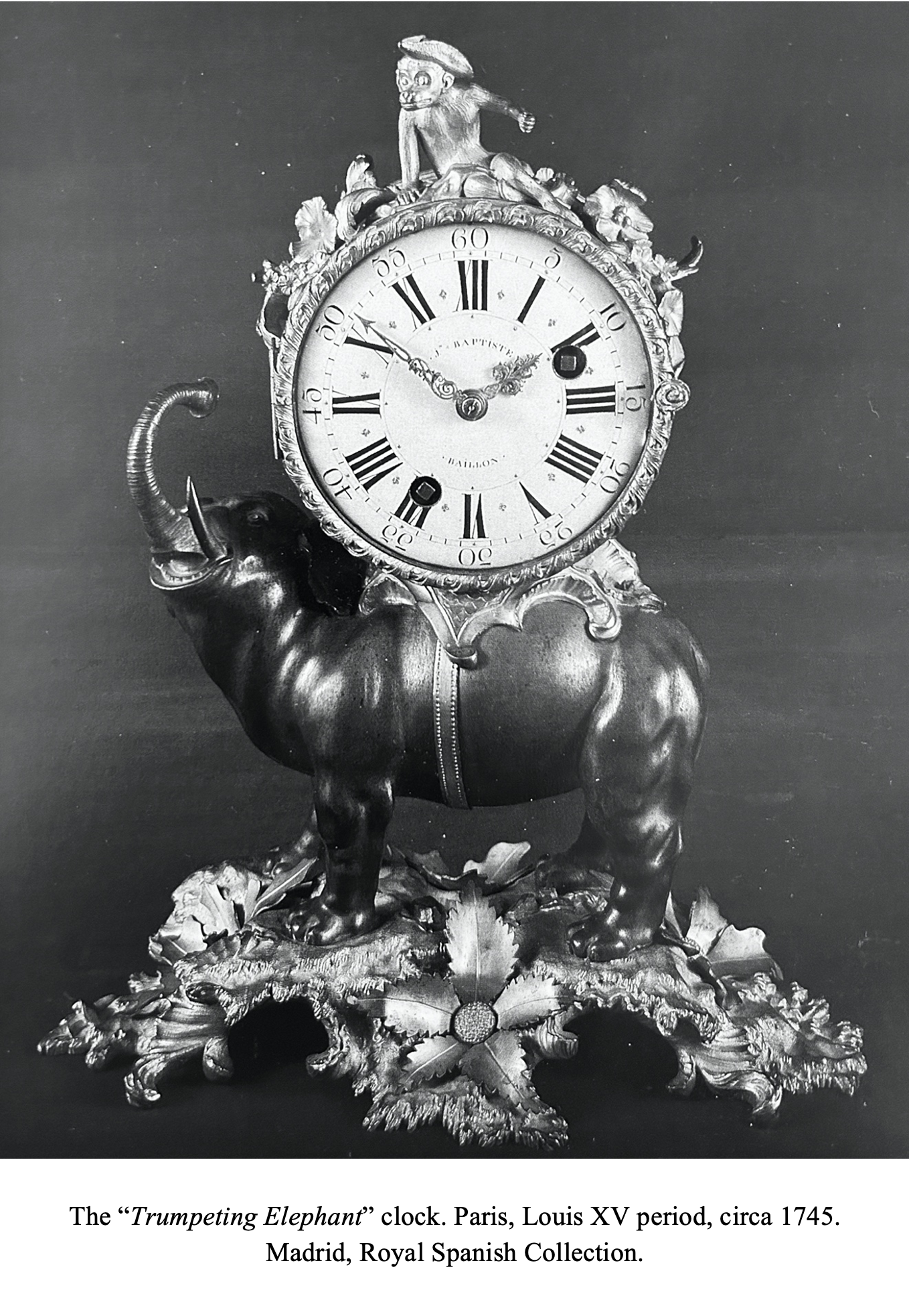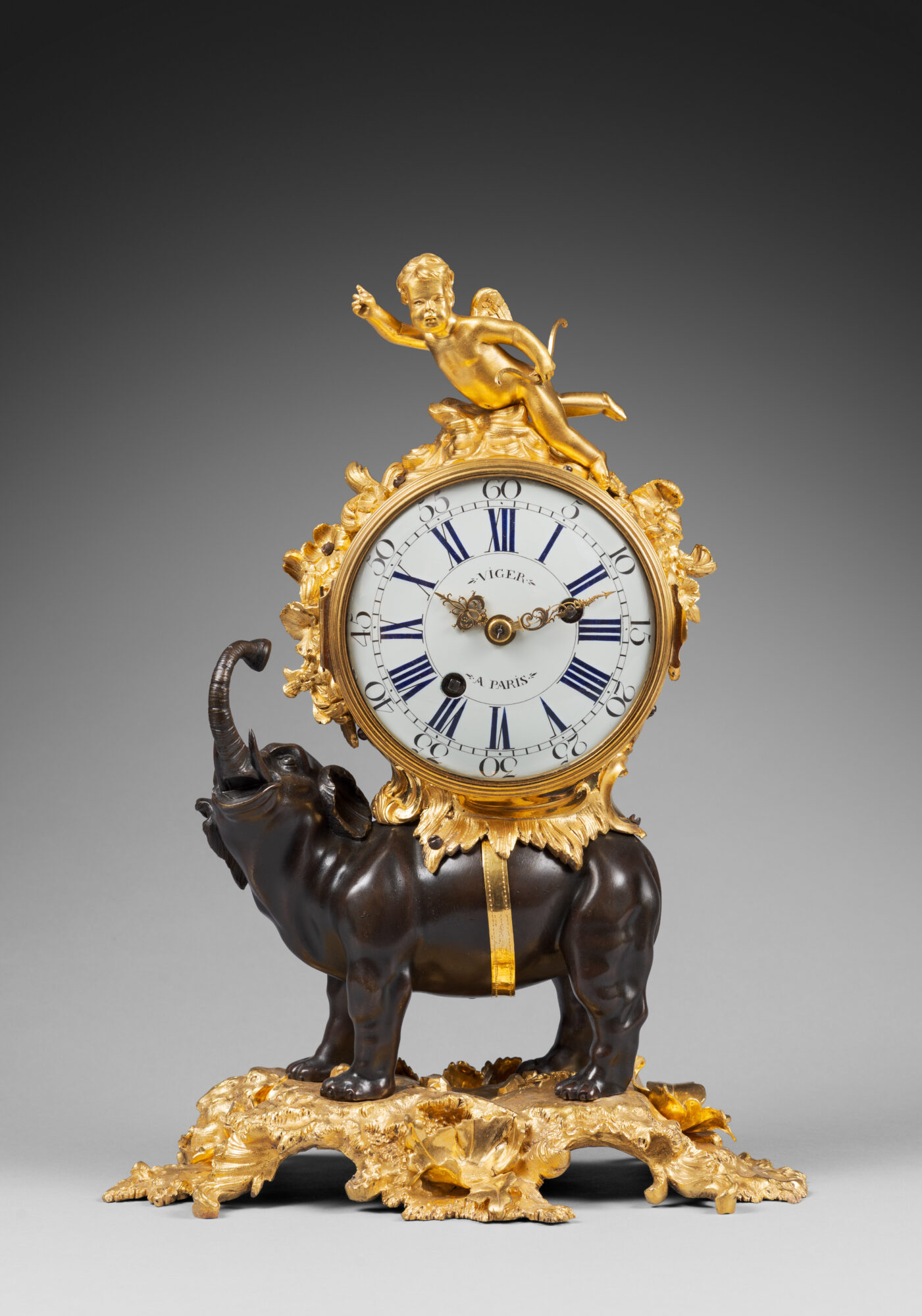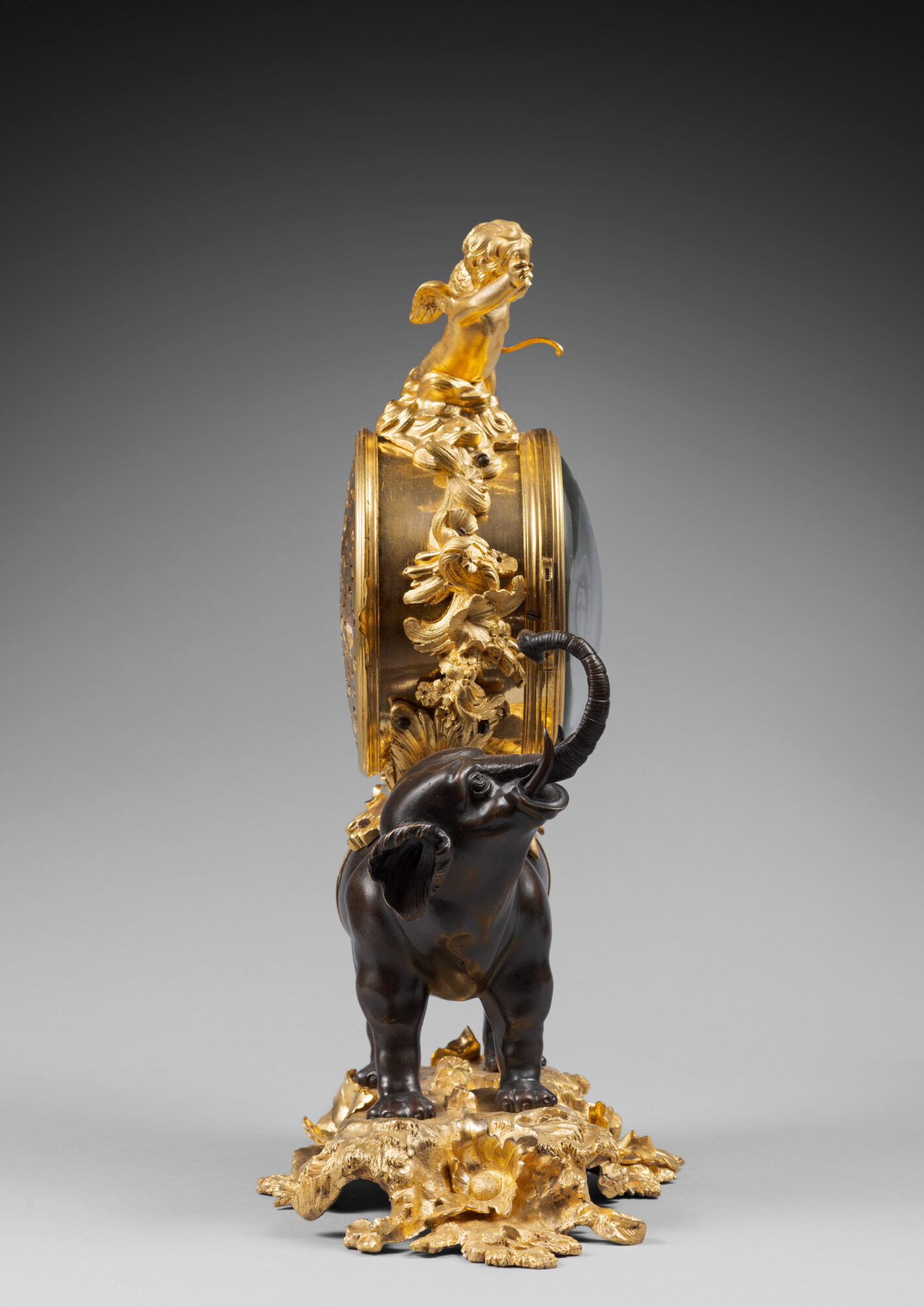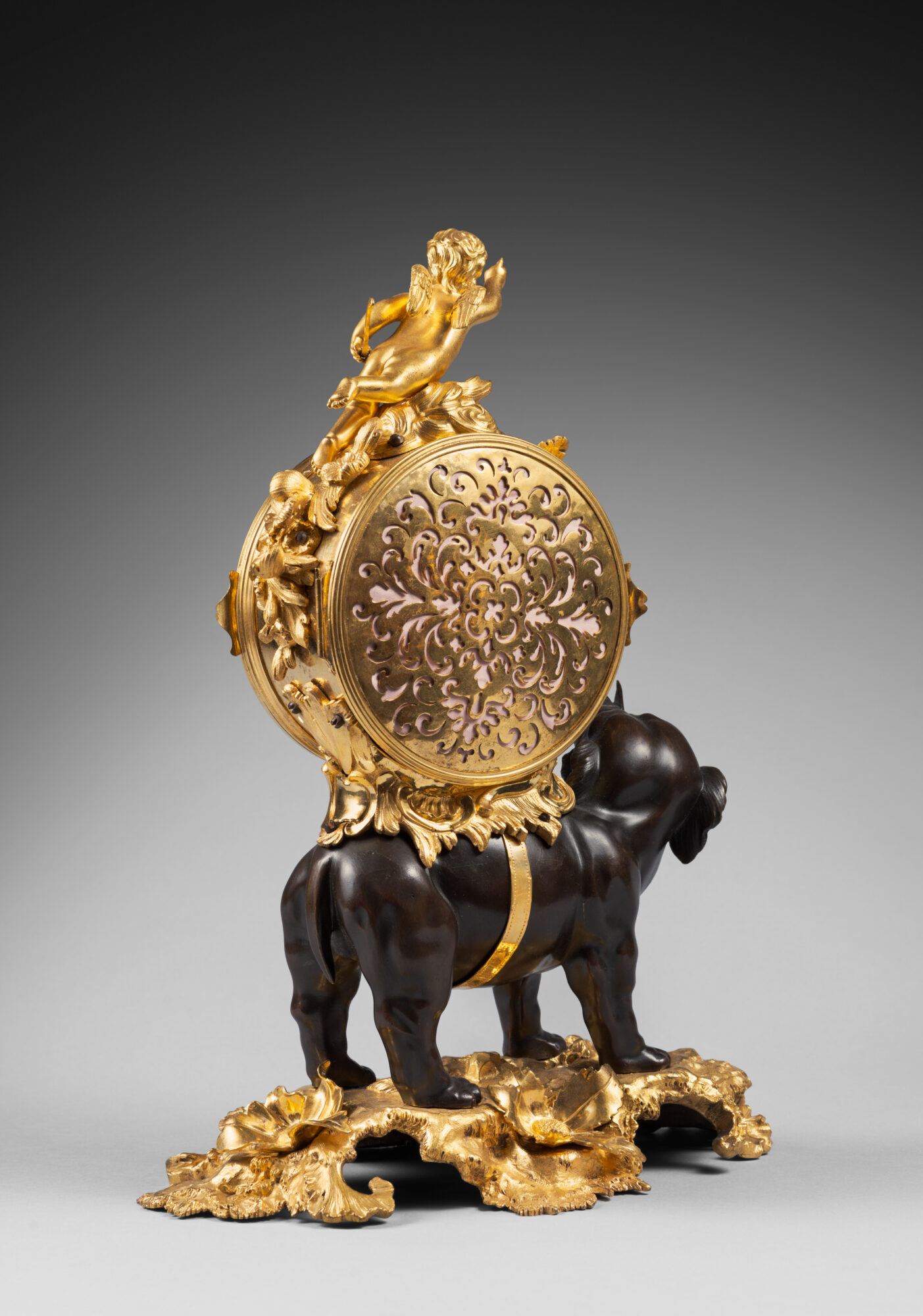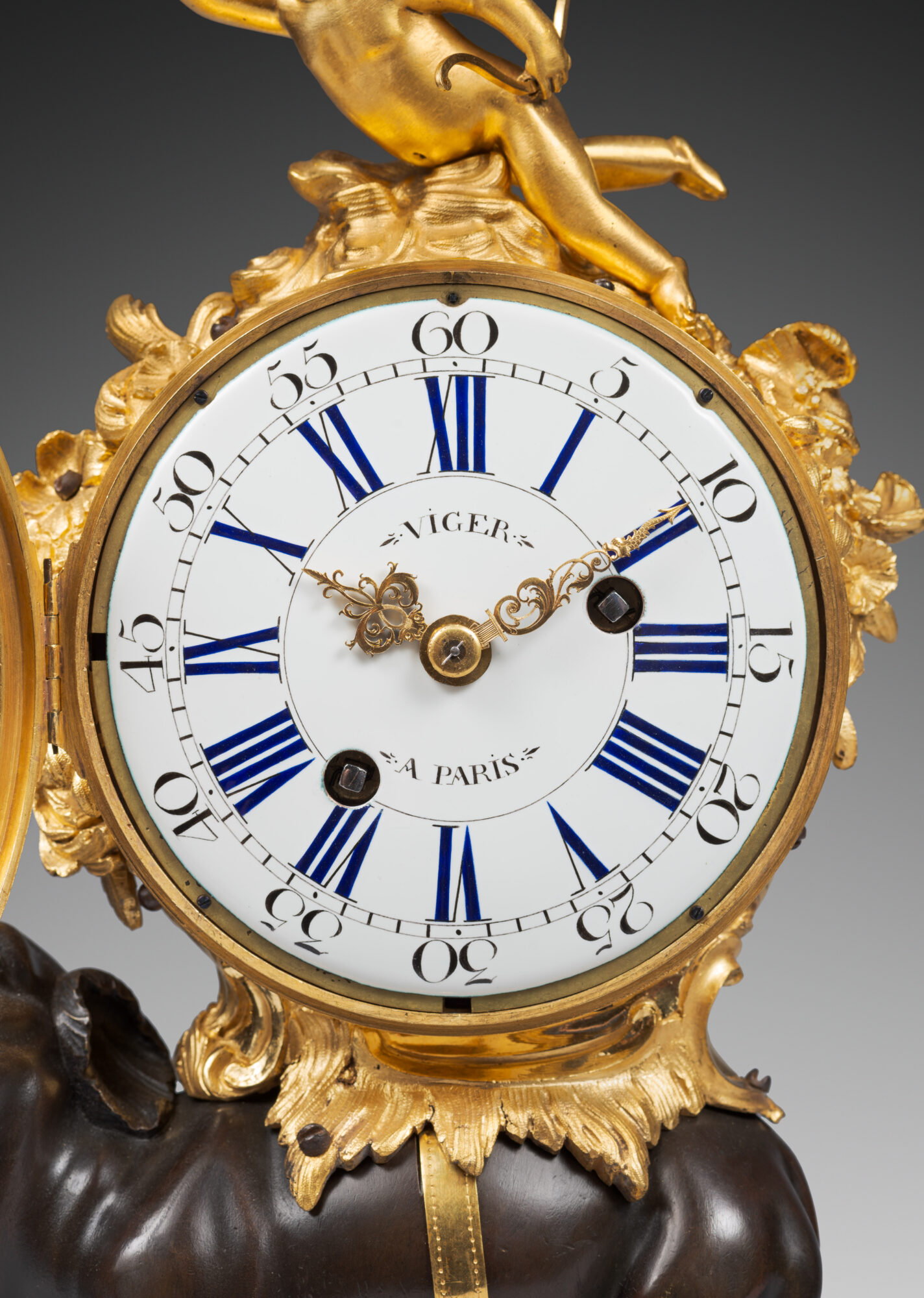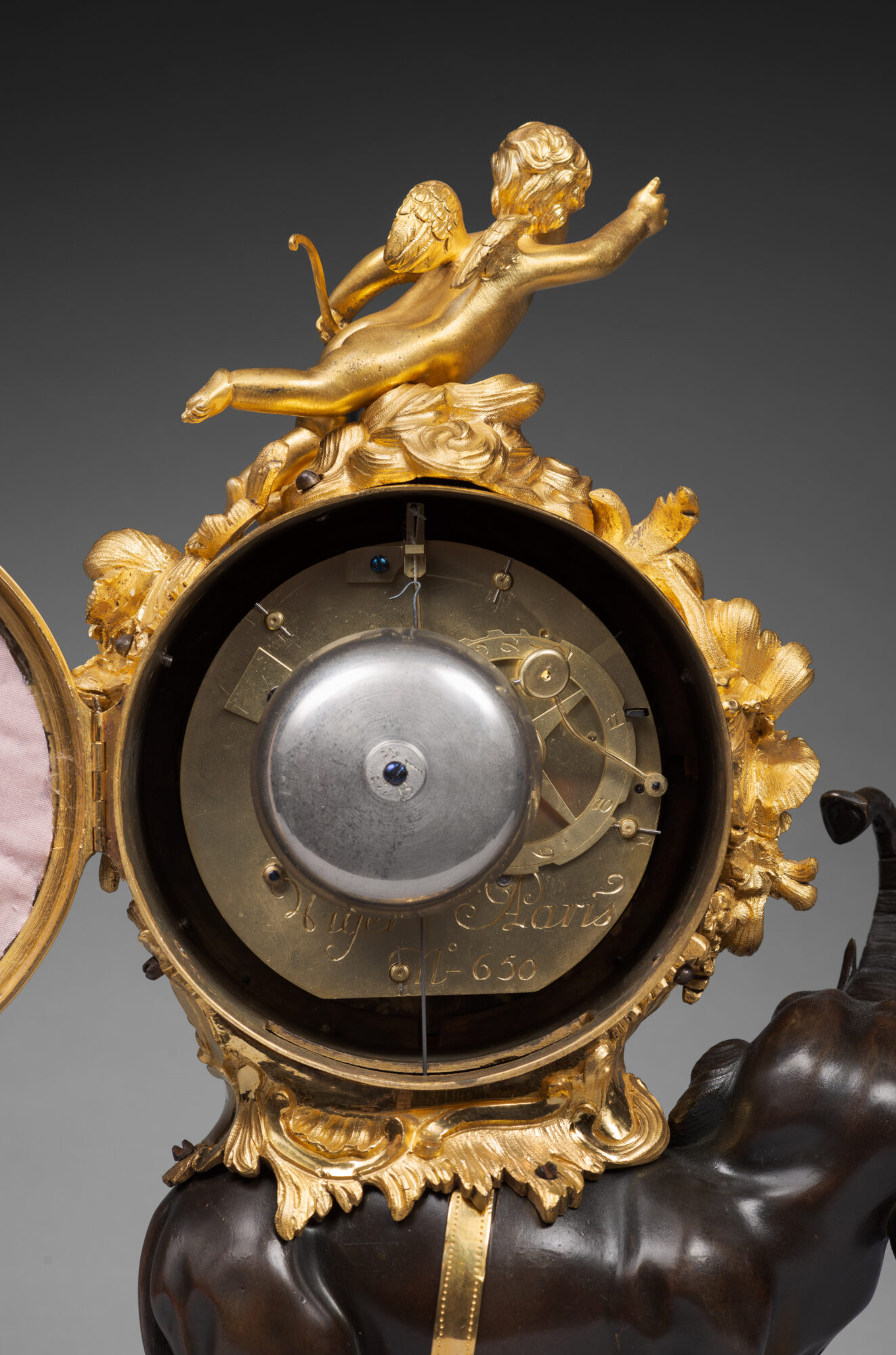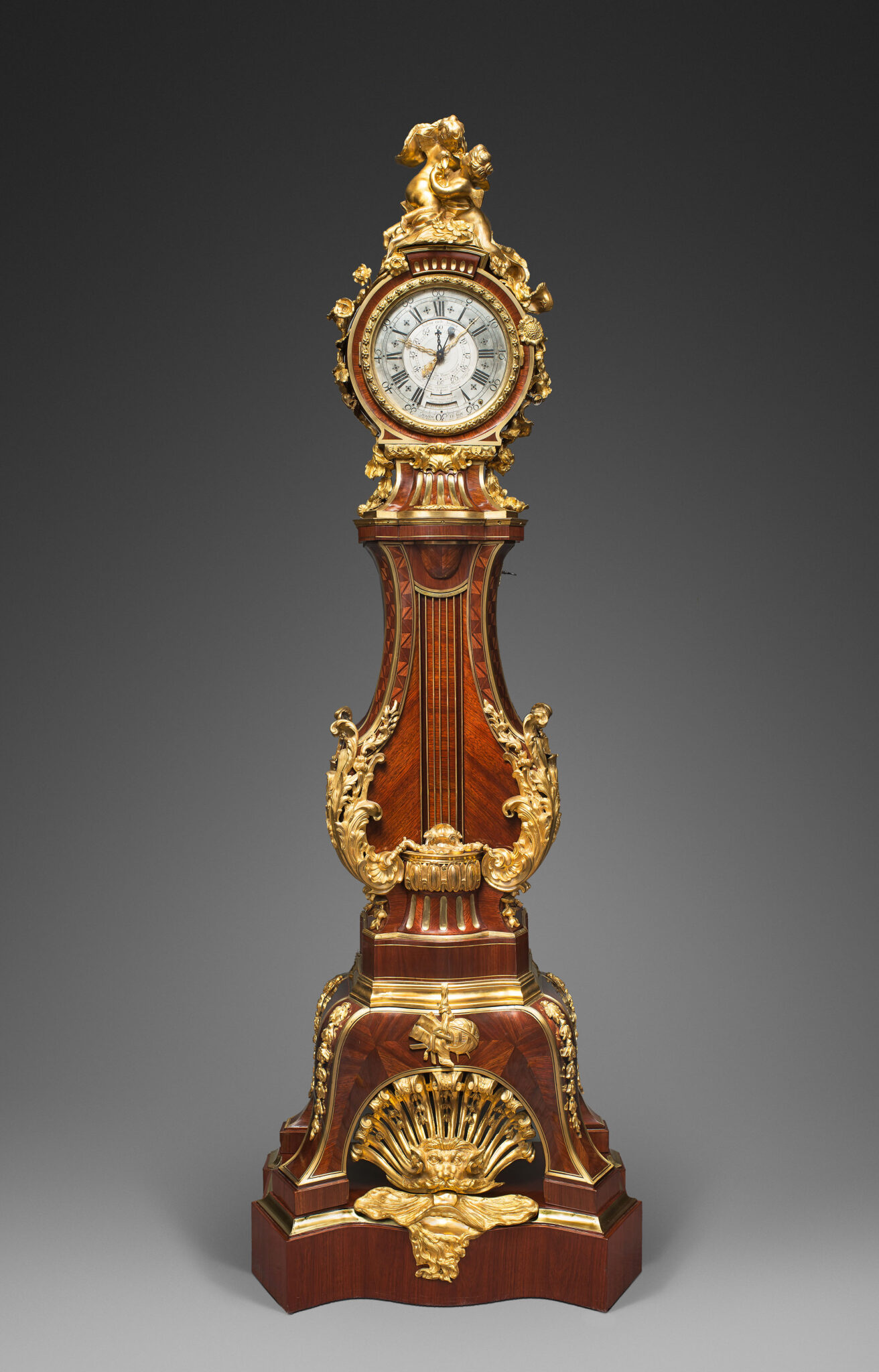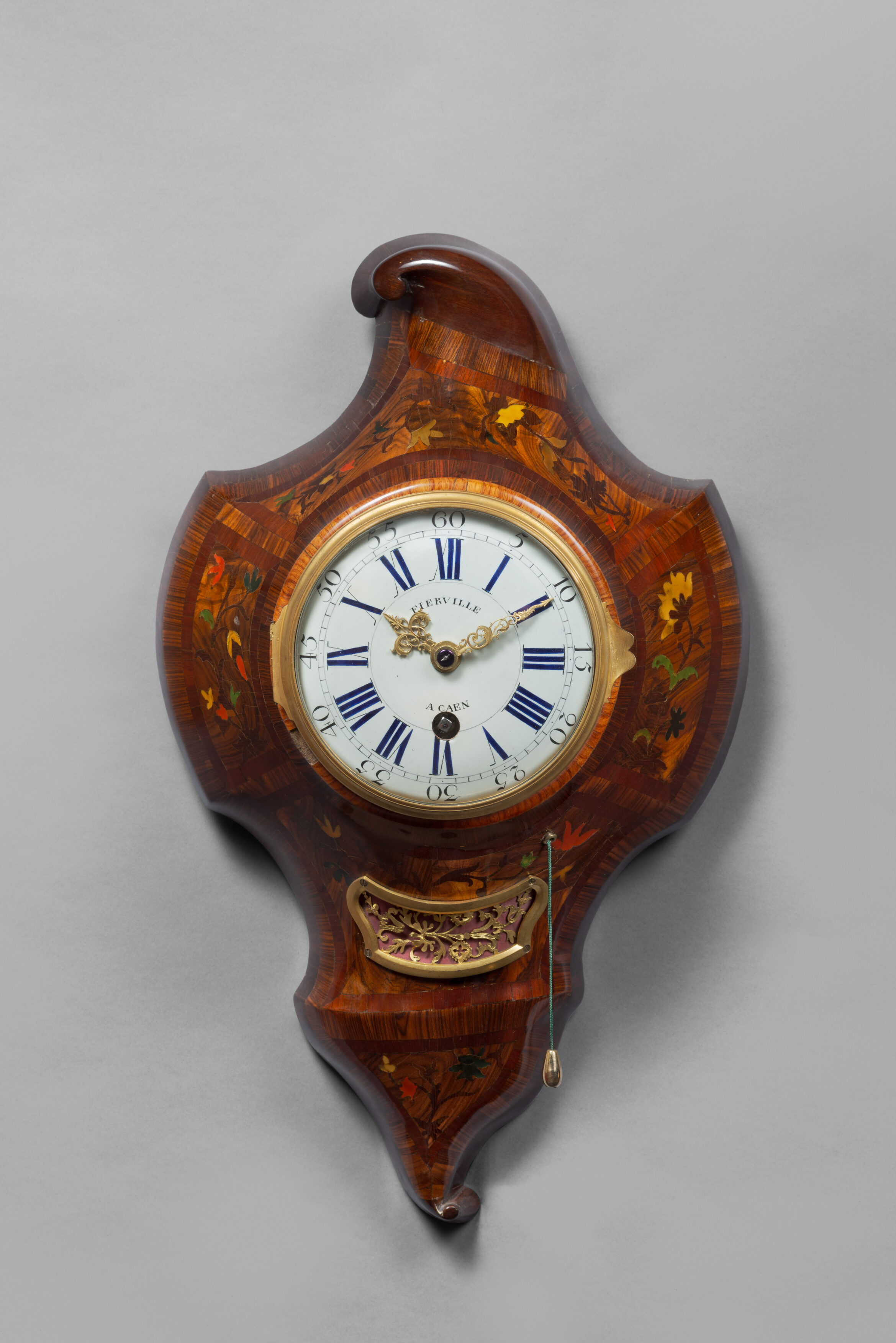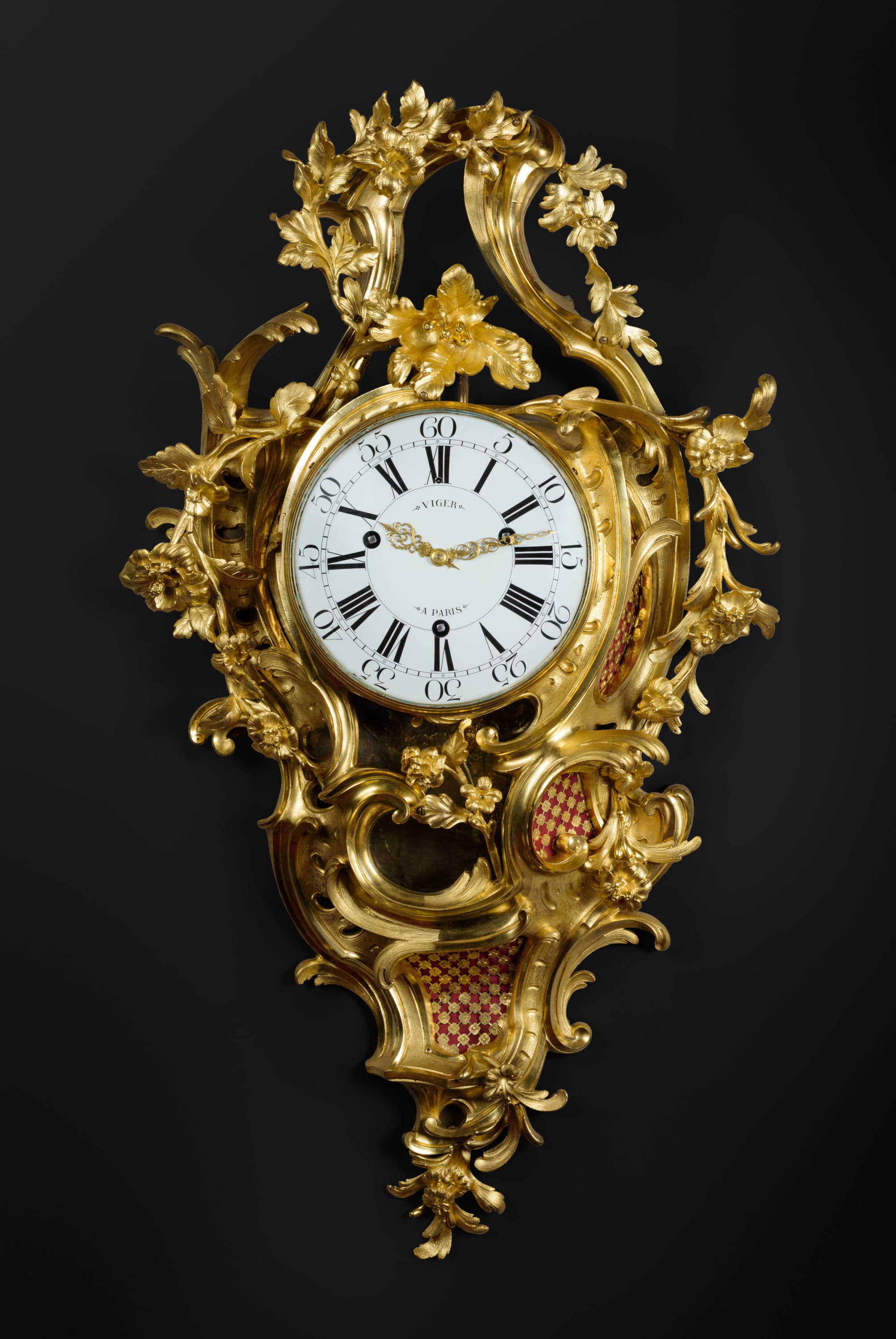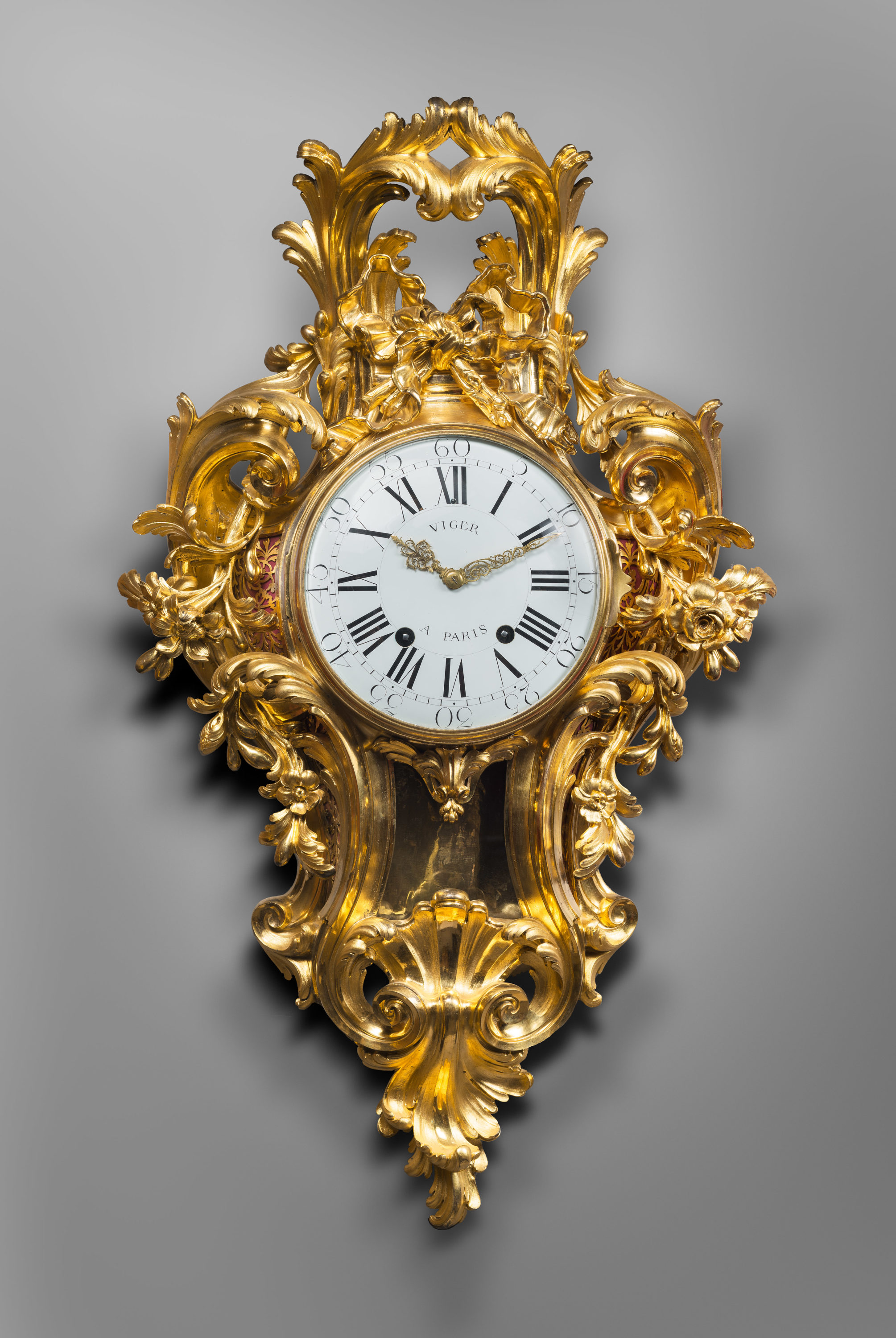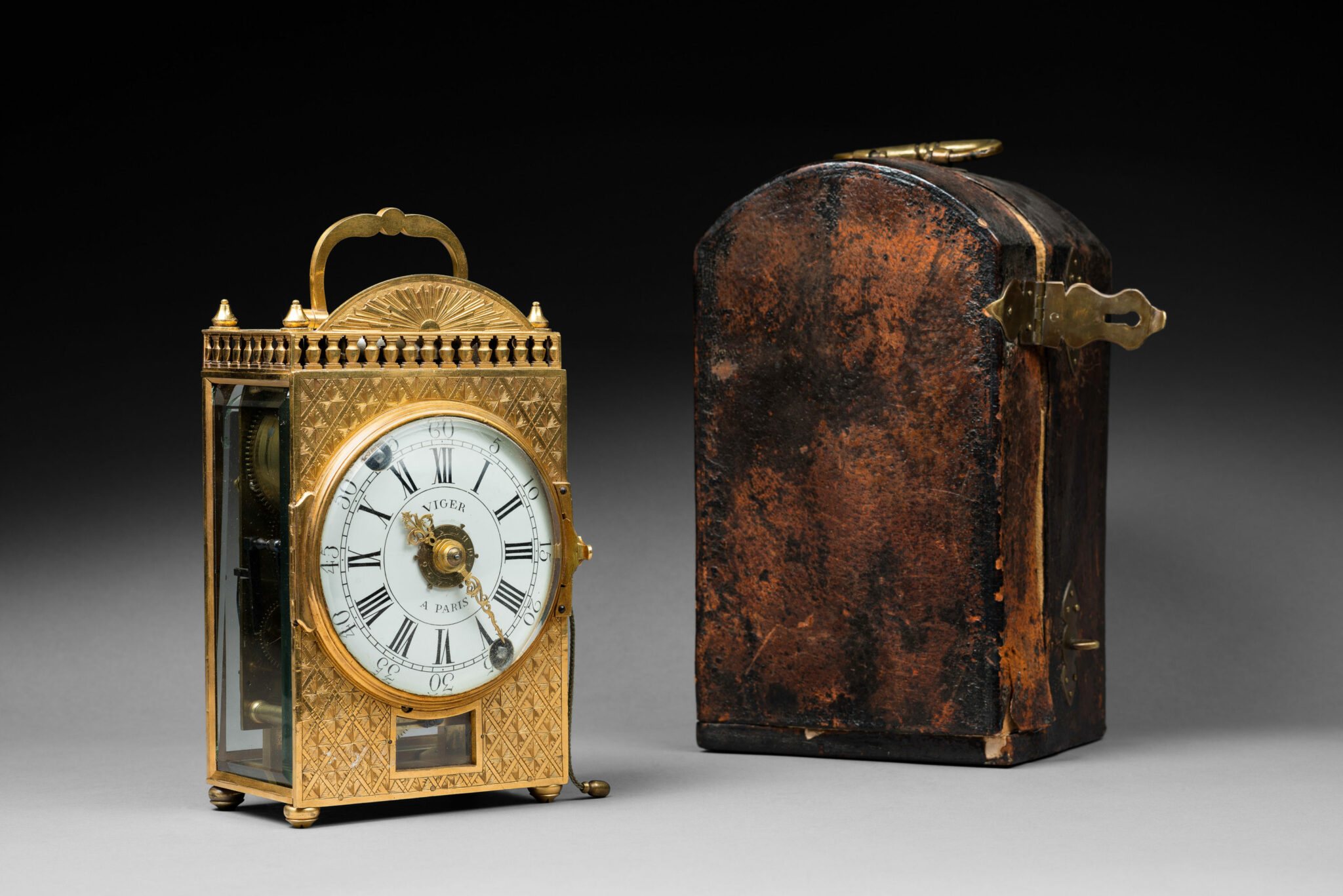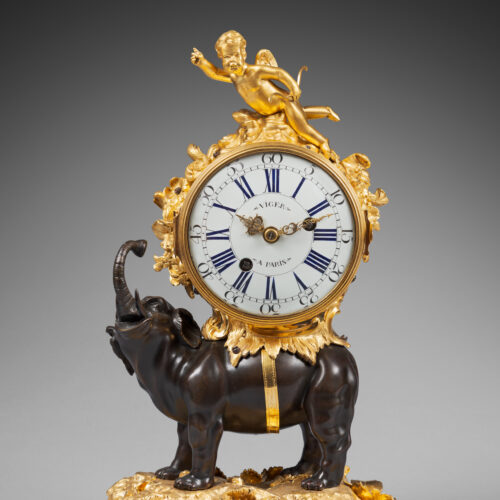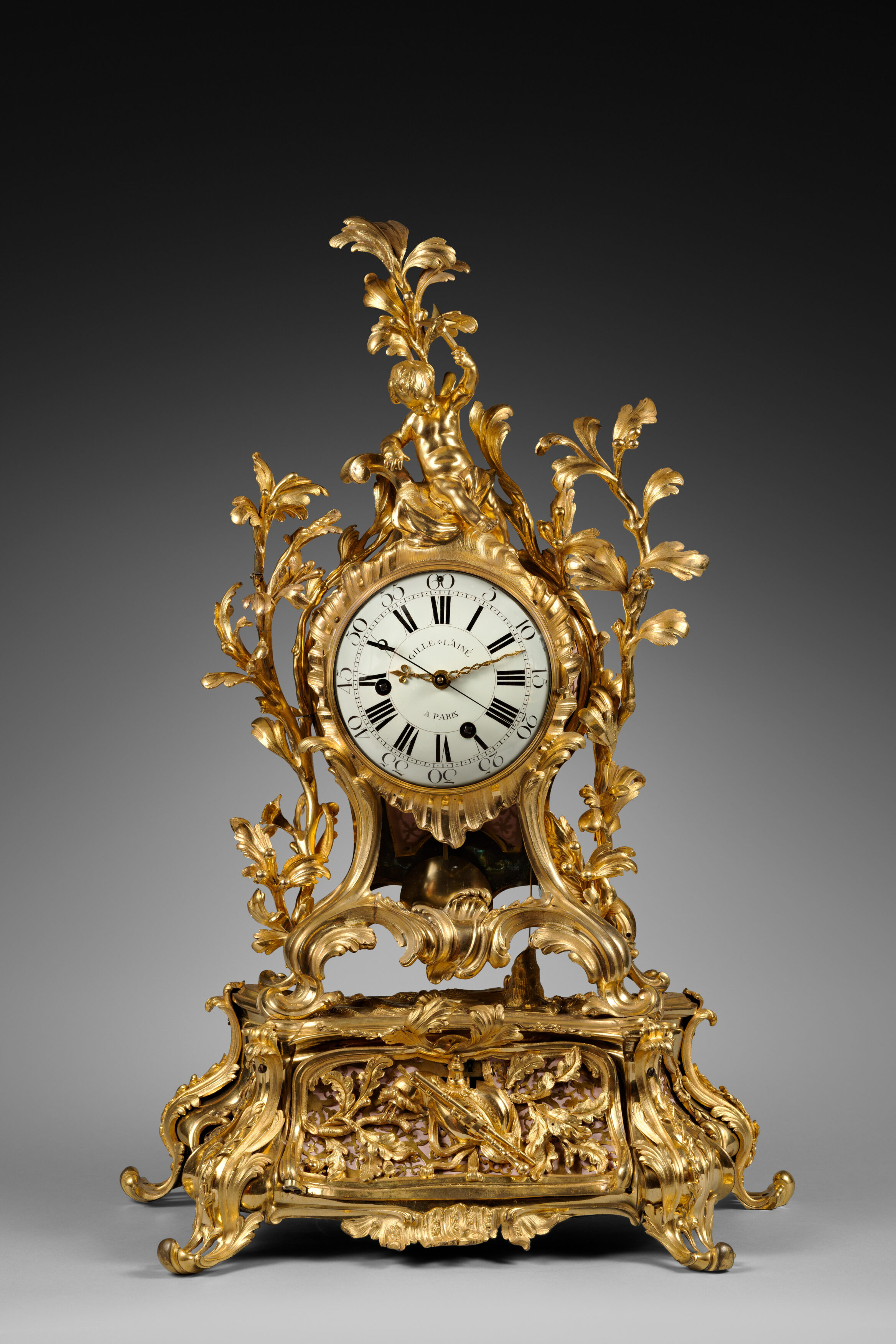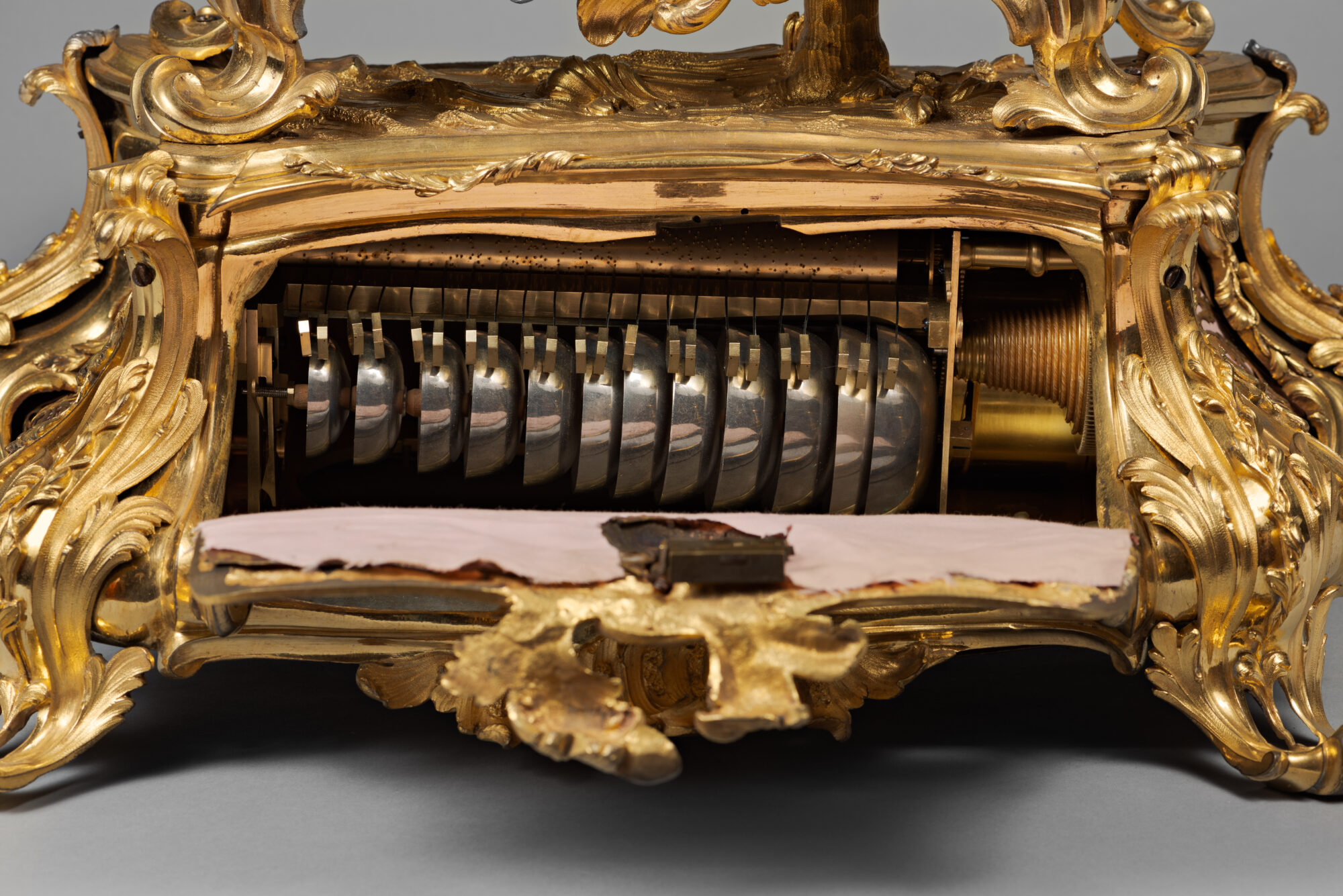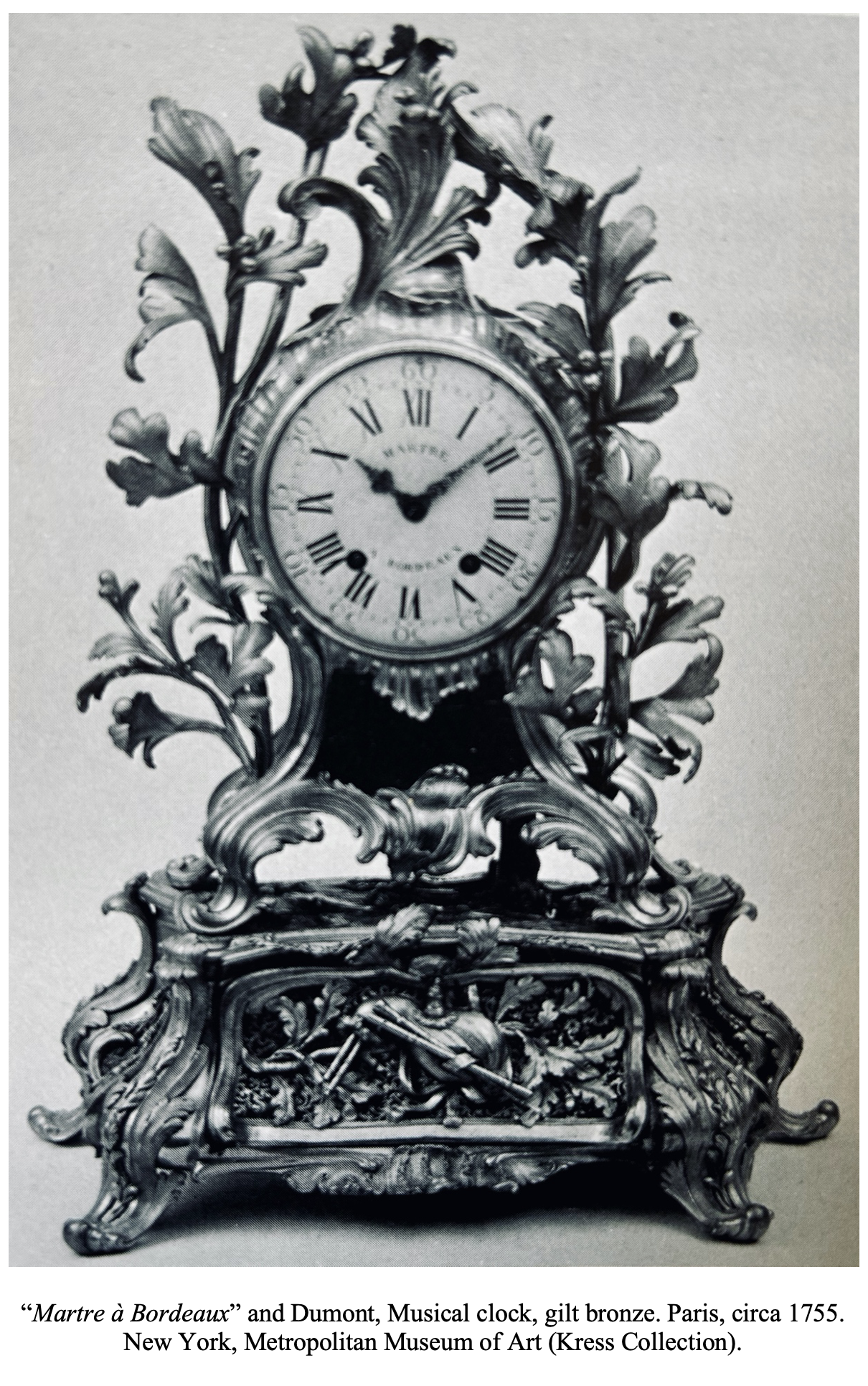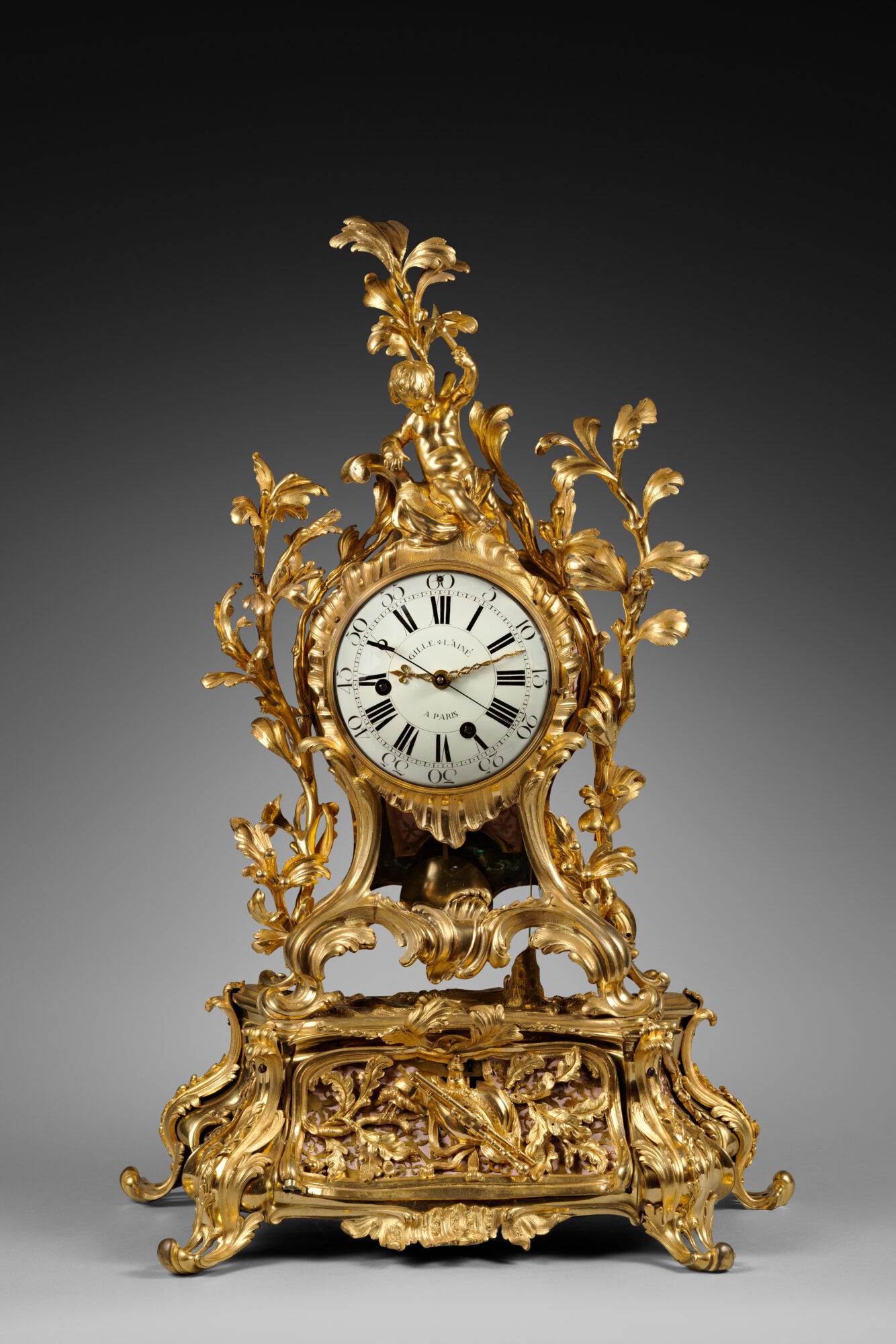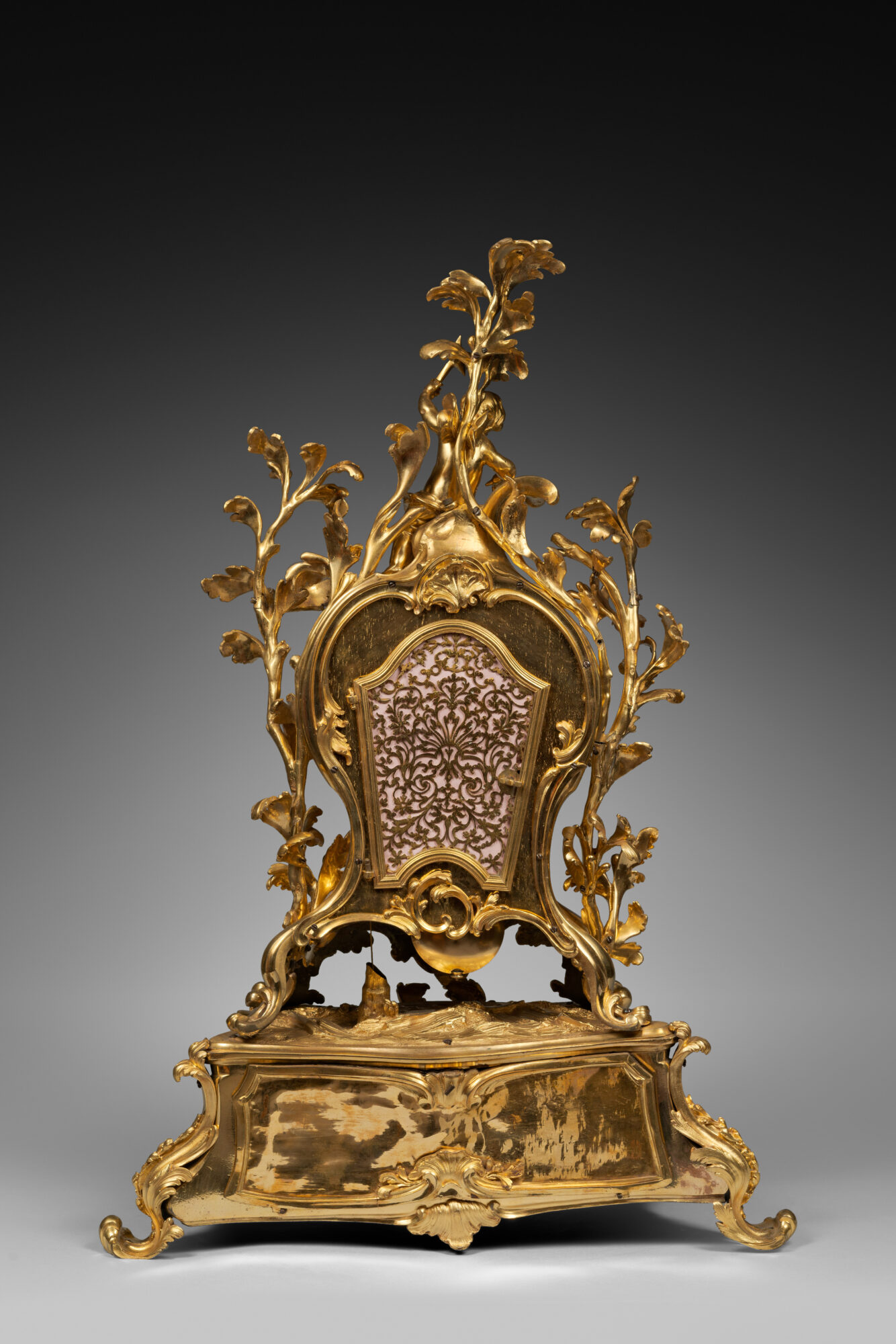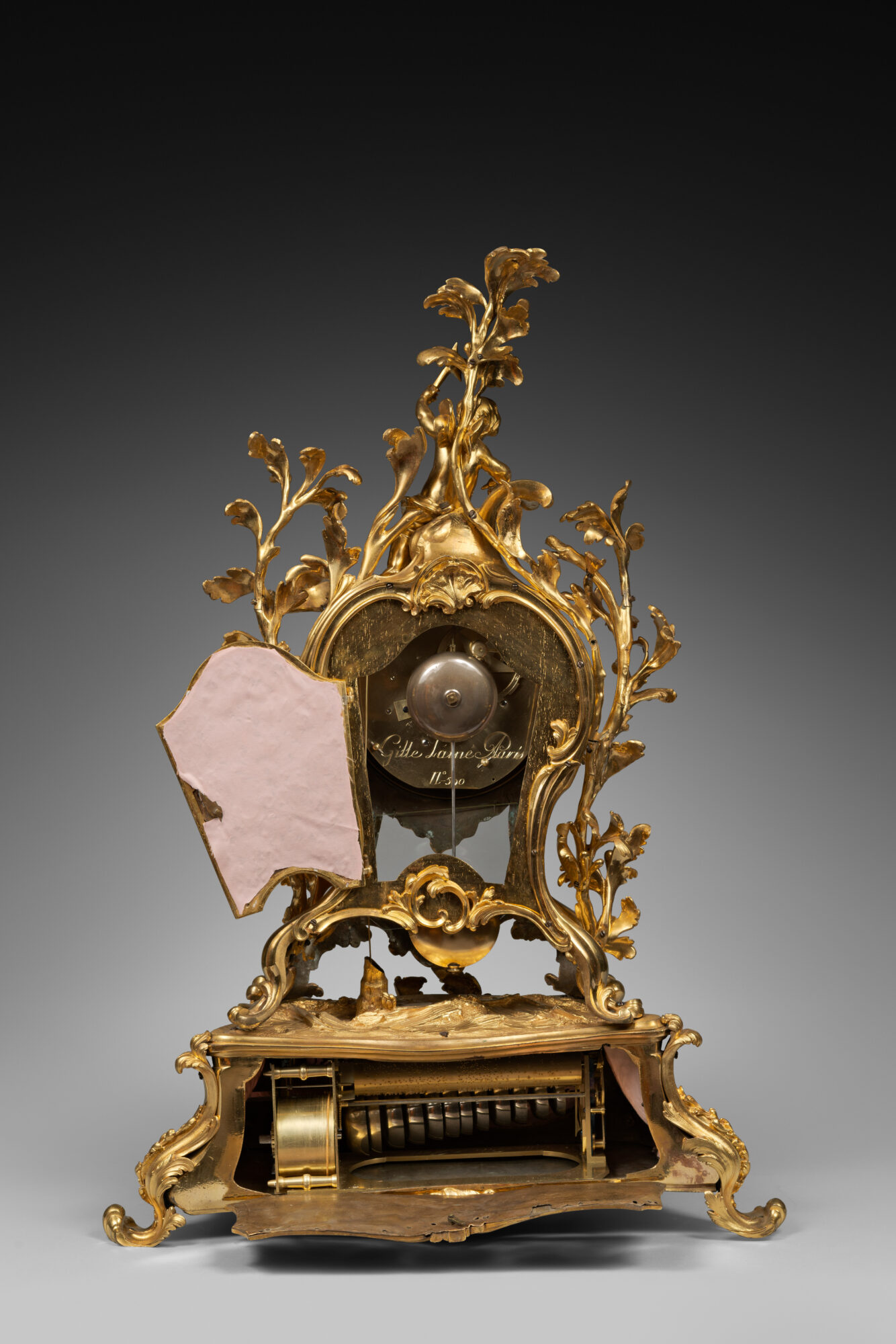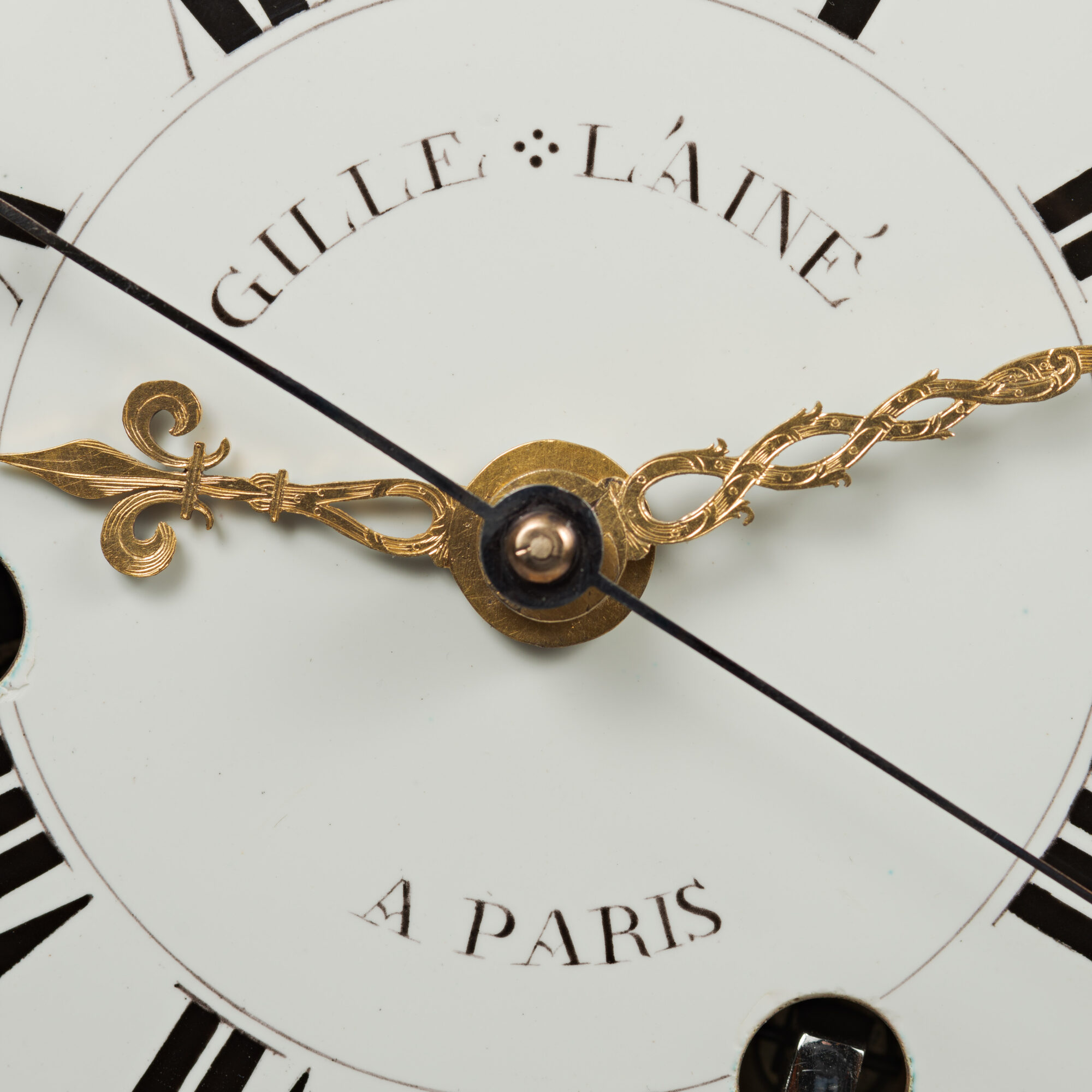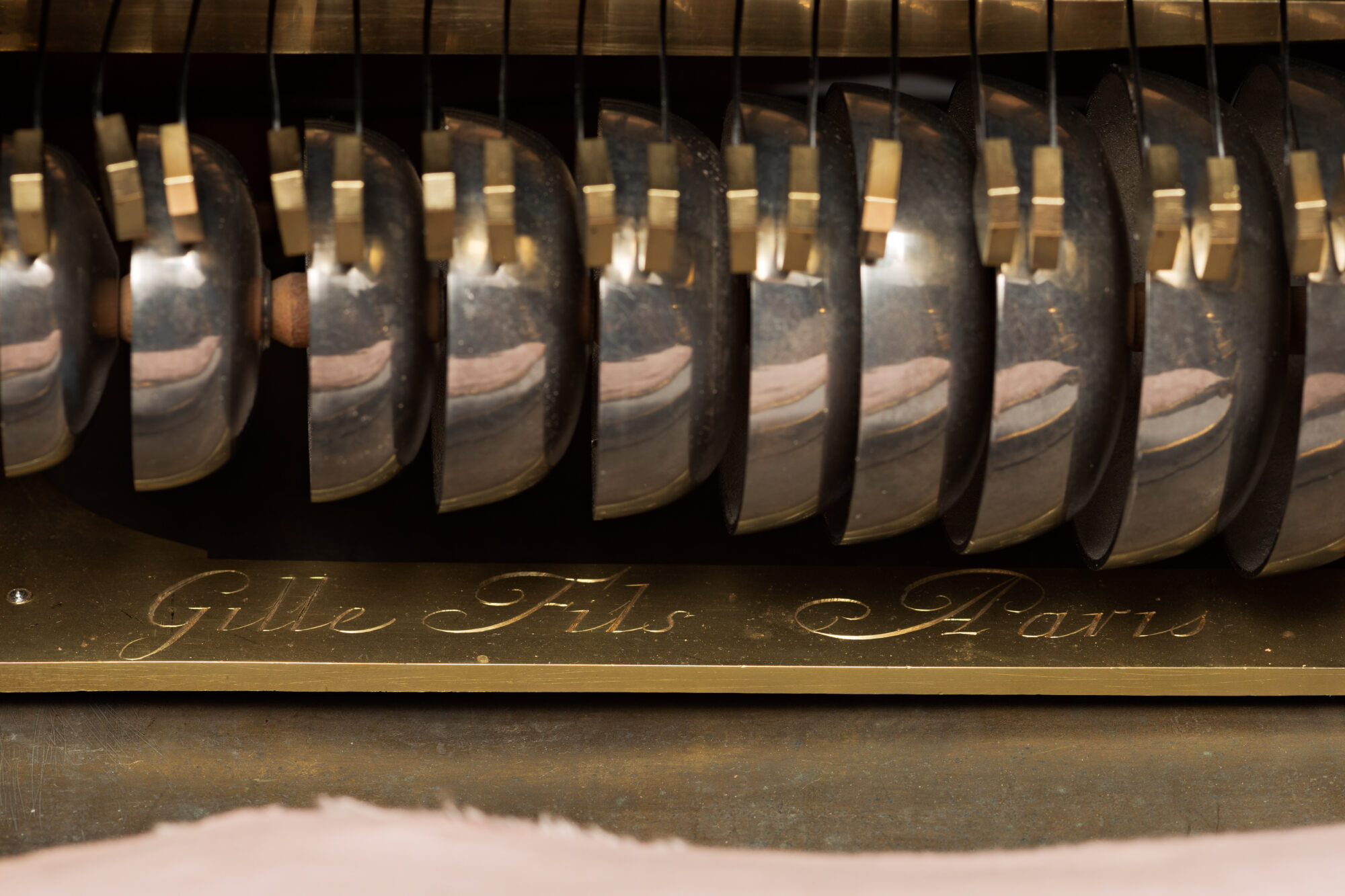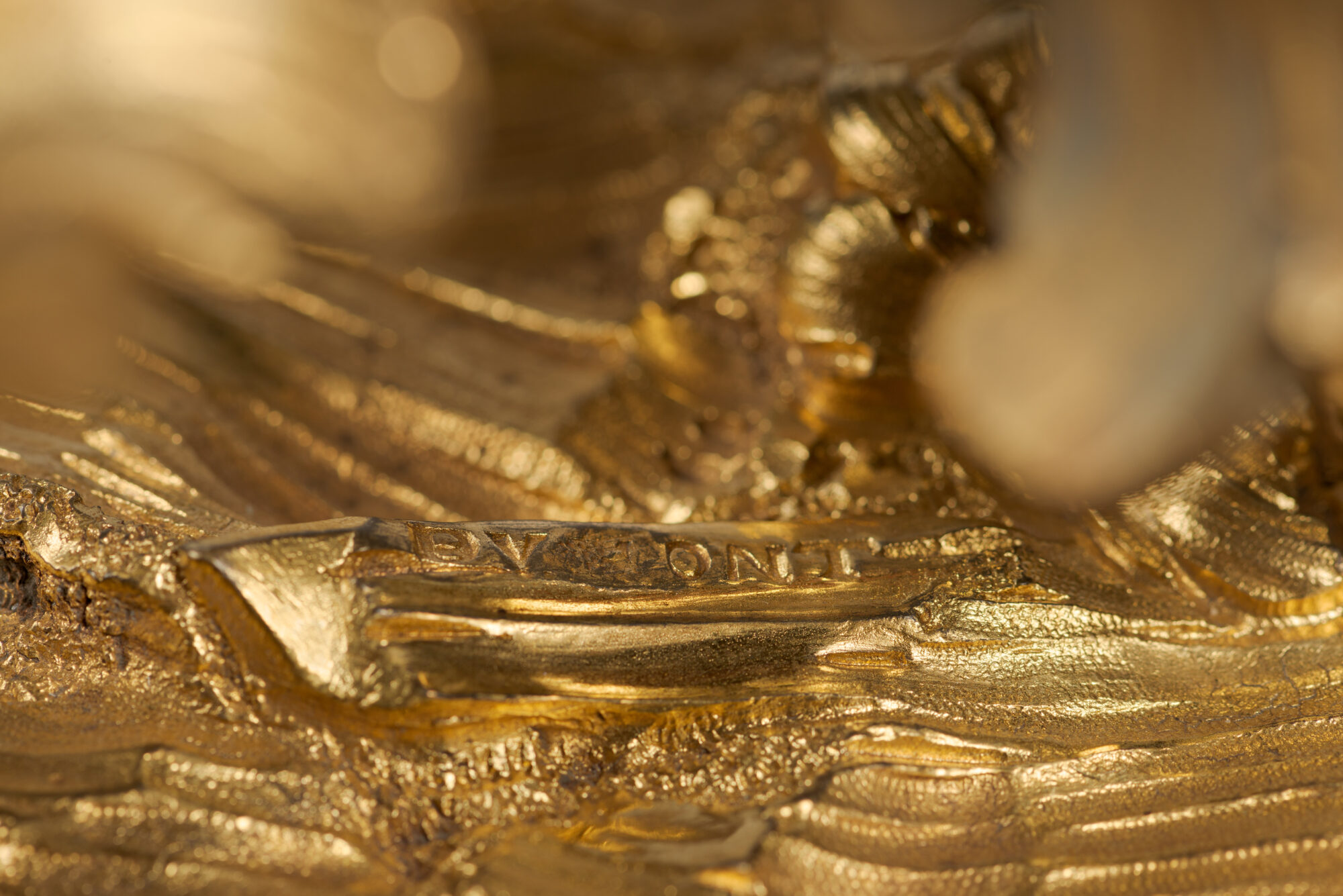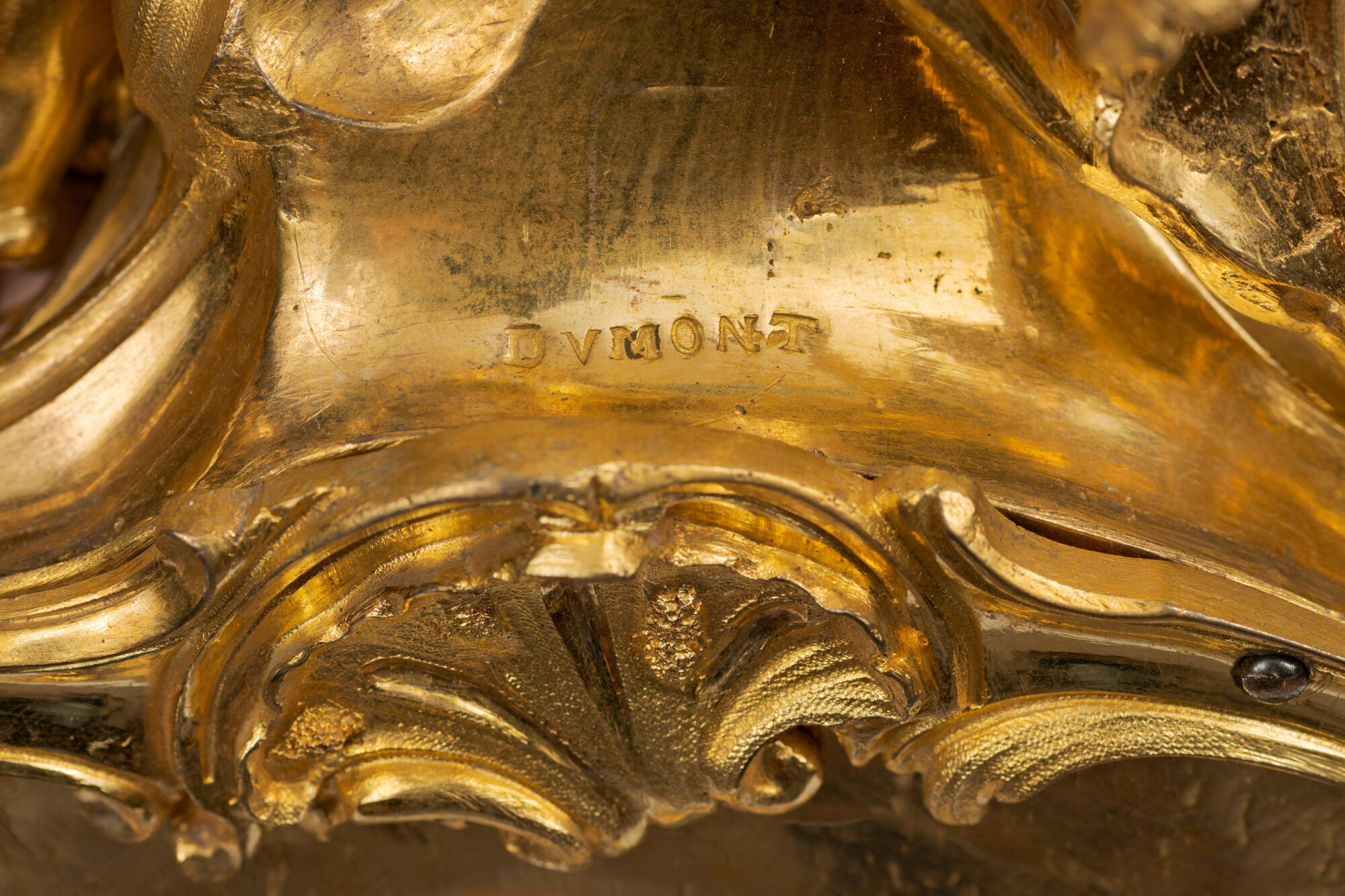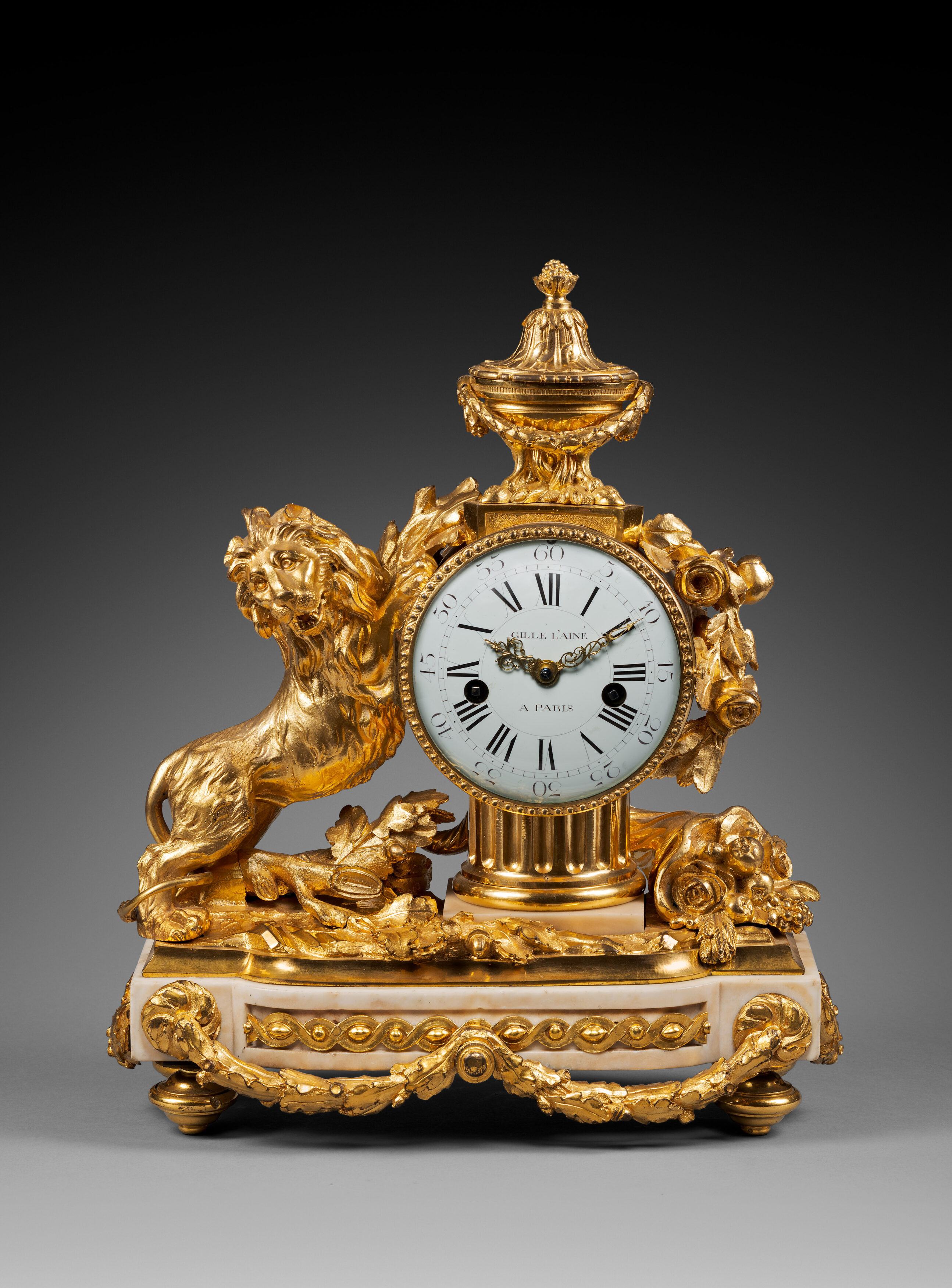Rare Gilt and Patinated Bronze Mantel Clock
The Trumpeting Elephant and Putto
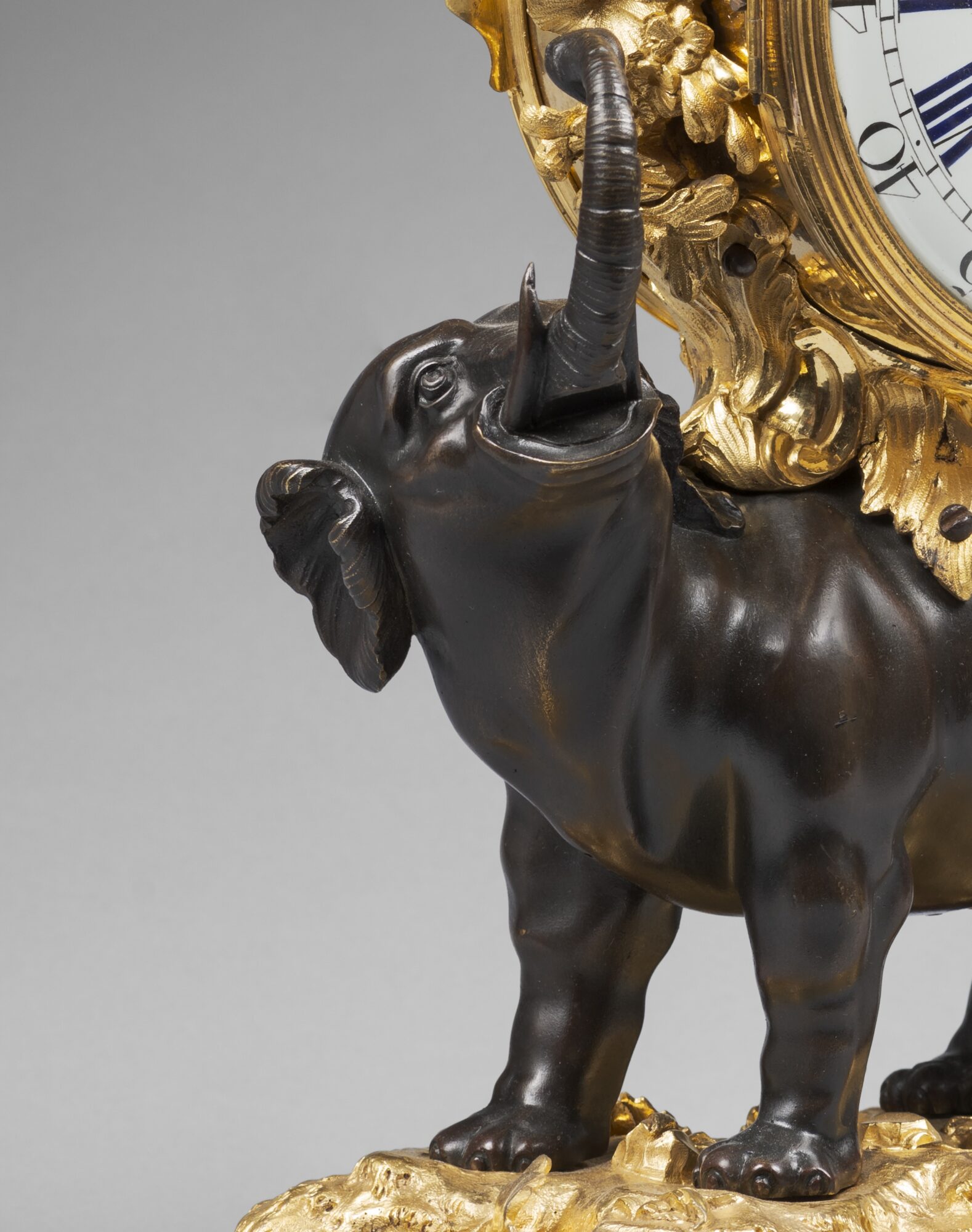
Dial signed “Viger à Paris” for clockmaker François Viger
Case attributed to Jean-Joseph de Saint-Germain
Paris, Louis XV period, circa 1745-1750
The round white enamel dial, signed “Viger à Paris”, indicates the Roman numeral hours and the Arabic five-minute intervals by means of two pierced gilt bronze hands. The hour and half-hour striking movement, whose plate is also signed “Viger à Paris” and numbered “650”, is housed in a case made of finely chased gilt and patinated bronze. Surmounting the clock, there is a winged putto flying above the clouds and holding a bow in his left hand. The circular case is adorned with garlands of flowers and leaves; it rests on the back of a trumpeting elephant with a raised trunk, which is standing on a rocaille terrace in the form of a rocky ground adorned with flowers.
The mid-18th century was a particularly creative period in the French decorative arts. Much was done at the time to favor the development of exceptionally talented artists and artisans and to incite them to come, from all over Europe, to create pieces for influential Parisian collectors. This was the context in which the present clock was made. Its unusual design, depicting a trumpeting elephant standing on a rocaille base, dates from the mid-18th century. Several variations of it are known, particularly as concerns the figure at the clock’s summit. Some clocks are surmounted by a monkey holding a parasol; others feature a shorebird being surprised by a dog; a further, rarer variation is that of a winged putto holding a bow, as in the present example. The model may be attributed to Jean-Joseph de Saint-Germain, for another clock of this type, made of gilt bronze and signed by Saint-Germain, was offered on the Parisian art market (sold Paris, Hôtel Drouot, Maître Lombrail, June 18, 2008, lot 150). Saint-Germain specialized in horological creations featuring animals such as bulls, lions, elephants, rhinoceroses, and wild boars, and produced variations of them over the course of several decades. As concerns elephant clocks in particular, he made another successful model in which the composition was inverted and was surmounted by a young child holding a sundial (one such clock is illustrated in Tardy, La pendule française, Ier Partie: de l’horloge gothique à la pendule Louis XV, Paris, 1975, p. 171).
Only a small number of identical clocks are known, some featuring minor variations in design. In the case of clocks surmounted by a monkey, one example is in the Residence in Bamberg (illustrated in H. Ottomeyer and P. Pröschel, Vergoldete Bronzen, Band I, Munich, 1986, p. 124, fig. 2.8.5). A second is in the Spanish Royal Collection (see J. Ramon Colon de Carvajal, Catalogo de Relojes del Patrimonio Nacional, Madrid, 1987, p. 23). One further such clock is in the collection of the Princes of Hesse in the Fasanerie Palace in Fulda (illustrated in the exhibition catalogue Gehäuse der Zeit, 2002, p. 93). As for models adorned by a sculptural group with a shorebird, one example, signed “Jean-Baptiste Baillon”, was formerly in the collection of Mrs. Anna Thomson Dodge (sold Christie’s, London, June 24, 1971, lot 39). Lastly, for the model with a surmounting putto, one clock, whose dial is signed “Renard à Reims”, was offered at auction when the collection of the Countess de Maigret was sold (Paris, Hôtel Drouot, Maître Delaporte, March 10, 1980, lot 44). A second example is illustrated in E. Niehüser, Die französische Bronzeuhr, Eine Typologie der figürlichen Darstellungen, Munich, 1997, p. 242, fig. 893.
François Viger (circa 1708 - 1784)
An 18th century Parisian clockmaker. Exercising independently at first, he became a master in August 1744 and opened a workshop in the rue Saint-Denis. As Jean-Dominique Augarde aptly states: “the pieces made in his workshop are of exceptional quality”. (Les ouvriers du Temps, Genève, 1996, p. 405). Viger ordered his clock cases from the best bronziers and cabinetmakers of the day, collaborating with such fine artisans as Jean-Joseph de Saint-Germain, Antoine Foullet, and Jean-Baptiste Osmond. His work may be found today in important museums and private collections worldwide, including the Basel Historisches Museum de Bâle, the Wallace Collection in London, the Louvre in Paris, the Hermitage in Saint Petersburg and the Liazenski Palace in Warsaw.
Jean-Joseph de Saint-Germain (1719 - 1791)
He was probably the most renowned Parisian of the mid 18th century. Active as of 1742, he did become a master craftsman until July 1748. He became famous for his many clock and cartel cases, such as his Diana the Huntress (an example is in the Louvre Museum), the clock supported by two Chinamen (a similar example is in the Musée des Arts décoratifs in Lyon), as well as several clocks based on animal themes, including elephant and rhinoceros clocks (an example in the Louvre Museum). In the early 1760’s he played an important role in the renewal of the French decorative arts and the development of the Neo-classical style, an important example of which may be seen in his Genius of Denmark clock, made for Frederic V and based on a model by Augustin Pajou (1765, in the Amalienborg Palace, Copenhagen). Saint-Germain also made several clocks inspired by the theme of Learning, or Study, based on a model by Louis-Félix de La Rue (examples in the Louvre Museum, the Gulbenkian Foundation, Lisbon, and the Metropolitan Museum in New York). Along with his clock cases, Saint-Germain also made bronze furniture mounts, such as fire dogs, wall lights, and candelabra. His entire body of work bears witness to his remarkable skills as a chaser and bronzeworker, as well as to his extraordinary creativity. He retired in 1776.
Discover our entire collection of rare clocks on La Pendulerie Paris.
